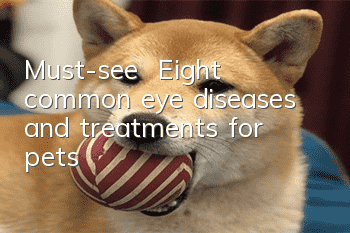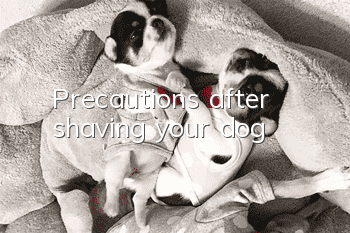Must-see | Eight common eye diseases and treatments for pets

Eight common eye diseases
1. Conjunctivitis
Cause: The conjunctiva covers the inner layer of the eyelids and extends to around the cornea. It is a thin layer of semi-permeable mucous membrane. The conjunctiva contains rich capillaries, sensory nerve endings and lymphocytes, so it is very sensitive.
Symptoms: Eyes are sensitive to light, tearing, conjunctiva becomes red and congested, serous to purulent secretions are discharged from the inner corners of the eyes, and the amount of eye feces increases.
Focus on prevention: Conjunctivitis is also a disease that dogs with flat faces are prone to. Dogs are also prone to conjunctivitis when the climate is dry in winter. Owners may consider using a humidifier and tear drops containing anti-inflammatory ingredients, which can also be used in large areas. Play a preventive role to a certain extent.
2. Keratitis
Keratitis is a general term for inflammation of the corneal tissue. It is characterized by corneal opacity, the formation of new blood vessels around the cornea or ciliary body congestion, fibrinoid deposition in the anterior chamber of the eye, corneal ulcers, perforations, and corneal pannus. Keratitis is usually divided into four types: superficial, pigmented, deep and ulcerative.
Symptoms: Traumatic keratitis, traces of trauma can be seen on the surface of the cornea, and the injured area is rough and uneven. Corneal epithelial damage and secondary infection may cause local white bulges - corneal infiltration. When the cornea forms an ulcer, it may cause tears and blurred vision. Or blepharospasm, the cornea appears light yellow or pure yellow turbidity. When large-area ulcers occur, corneal leukoplakia can be seen and even cause corneal fistulas. Keratitis caused by inflammatory stimulation often presents with corneal opacity. When the cornea is perforated, the aqueous humor surges out, and the iris can be rushed to the wound, causing partial prolapse of the iris, adhesion between the iris and the cornea, and miosis.
3. Tears
Dog tear stains are secreted from the eyes of pet dogs. The lacrimal gland is an accessory organ of the eye. Under normal circumstances, the lacrimal gland secretes tears to moisten the eyeball and then enters the nasal cavity through the tear duct. It will not flow out from the corner of the eye. For example, when an animal cries, the lacrimal gland secretes too much tear fluid and cannot be discharged from the tear duct. Tears will flow from the corners of the eyes. Over time, tear stains form. If your baby has serious tear stains, please take a closer look. Usually poodles, Pomeranians, Pekingese, and Shih Tzus are prone to it.
4. Hyperplasia of facial glands in the third eye
The third eyelid, also known as the nictitating membrane, covers the conjunctiva to protect the cornea, remove foreign matter, and prevent excessive dryness of the eyes. If the third eyelid prolapses in one eye, it may be caused by eye irritation. The third eyelid is just a membrane, and there is no first and second eyelid relative to the "third eyelid". Animals generally have "The third eyelid. Commonly known as "cherry eye".
5. Inverted eyelashes
Some specific breeds, such as Chow Chows and Boxer Dogs, often have inverted eyelashes, which can irritate the eyes and cause them to become blurry, tearful, and inflamed. Some have one eye, some have both. It is possible for the upper and lower eyes and face, and there is a difference between eversion and entropion. The disease is mainly caused by genetics.
6. Oculofacial inflammation
Blepharitis is a non-contact-contagious eyelid inflammation that usually occurs in the lower eyelids and eyelashes. Its common feature is that the meibomian glands near the eyelids secrete excessive oily secretions, thus forming a suitable environment for bacterial growth. Recurrent styes (infections of the sebaceous glands of the eyelids) and chalazions (swelling caused by blockage of the meibomian glands) are also associated with blepharitis. Blepharitis usually does not affect vision or damage the eye. In most cases, this is a chronic, manageable condition. If left untreated, a severe case of ulcerative blepharitis may develop. This is usually caused by a bacterial infection and can lead to eyelash loss, eyelid scarring, and corneal infection.
7. Cataract
Cause: Congenital and hereditary: Some cataracts are congenital or hereditary, so when choosing animals, try to avoid young animals with congenital cataracts. Senile: It is common for the lenses of middle-aged and elderly animals to develop cloudy lesions due to aging.
Secondary: Cataracts are often secondary to other eye diseases, such as eye trauma, uveitis, lens dislocation, retinal disease, etc.
Symptoms: White areas can be seen in the pupils, the sick animals have visual impairment or even blindness, they bump into furniture or things when walking, and their flexibility of movement is reduced. Diabetes is usually more likely to occur in older dogs.
8. Glaucoma
There are also two types of glaucoma: congenital (primary) and acquired (secondary). Congenital glaucoma is related to genetic factors. Cocker Spaniels, Boston Terriers and Beagles are prone to it. Acquired glaucoma is not restricted by dog breeds. Dogs can all get sick. The drainage of atrial fluid between the cornea and the lens is blocked, causing an increase in intraocular pressure. The increase in intraocular pressure affects the optic nerve, resulting in weakened vision. The dog's vision is weakened, the eyeball is swollen, and the cornea protrudes outward.
Treatment method: There is still no effective treatment method. Therefore, if you suspect that your dog may have glaucoma, you should always take your dog to a specialized pet hospital to check the intraocular pressure.
Recommended Good Things
Aineng Pet Odor Eliminating Disinfectant can effectively remove body odor/feces odor and other odor molecules! Effective in treating skin diseases caused by fungi/bacteria! Can kill parvovirus/canine distemper virus/coronavirusetc!
It is edible grade for pets, does not contain fragrances, does not contain chemicals, can be sprayed directly, and is harmless to human pets!
Consultation: 13028809308 (WeChat synchronization)
Scan the QR code on WeChat to enter the purchase
- Why is my dog’s belly so hot?
- To train your dog to follow, learn these 5 “killer tricks” to make your dog never leave you!
- How to train Russian Shepherd Dog to be obedient
- What are the symptoms of worms outside the dog's body?
- When can puppy’s nails be cut?
- How much does an Alaskan dog cost and is it easy to train | Pictures
- How many menstrual periods does a dog have in a year?
- Is the Wolf Green Dog expensive? Training methods | Pictures
- What to do about canine distemper in American Bully dogs
- Why does a dog vomit? What should I do if my dog vomits?



